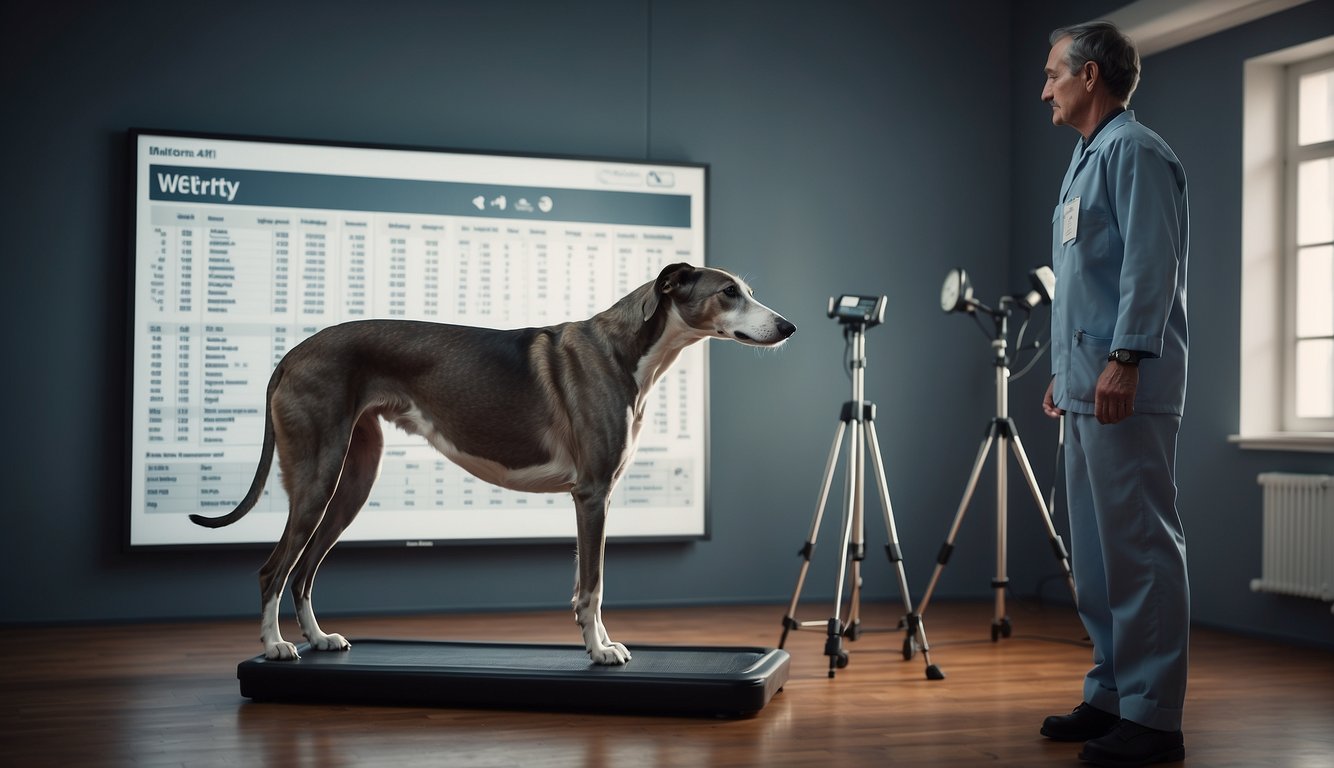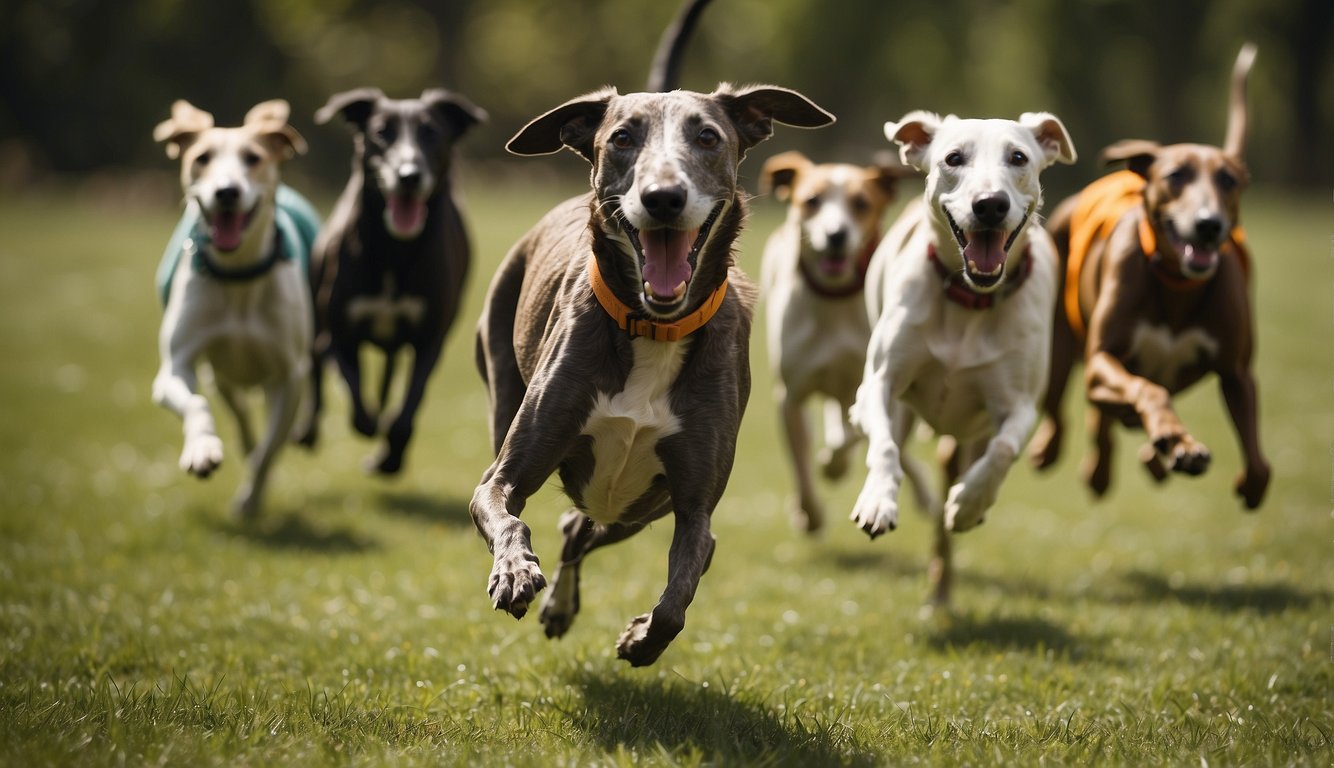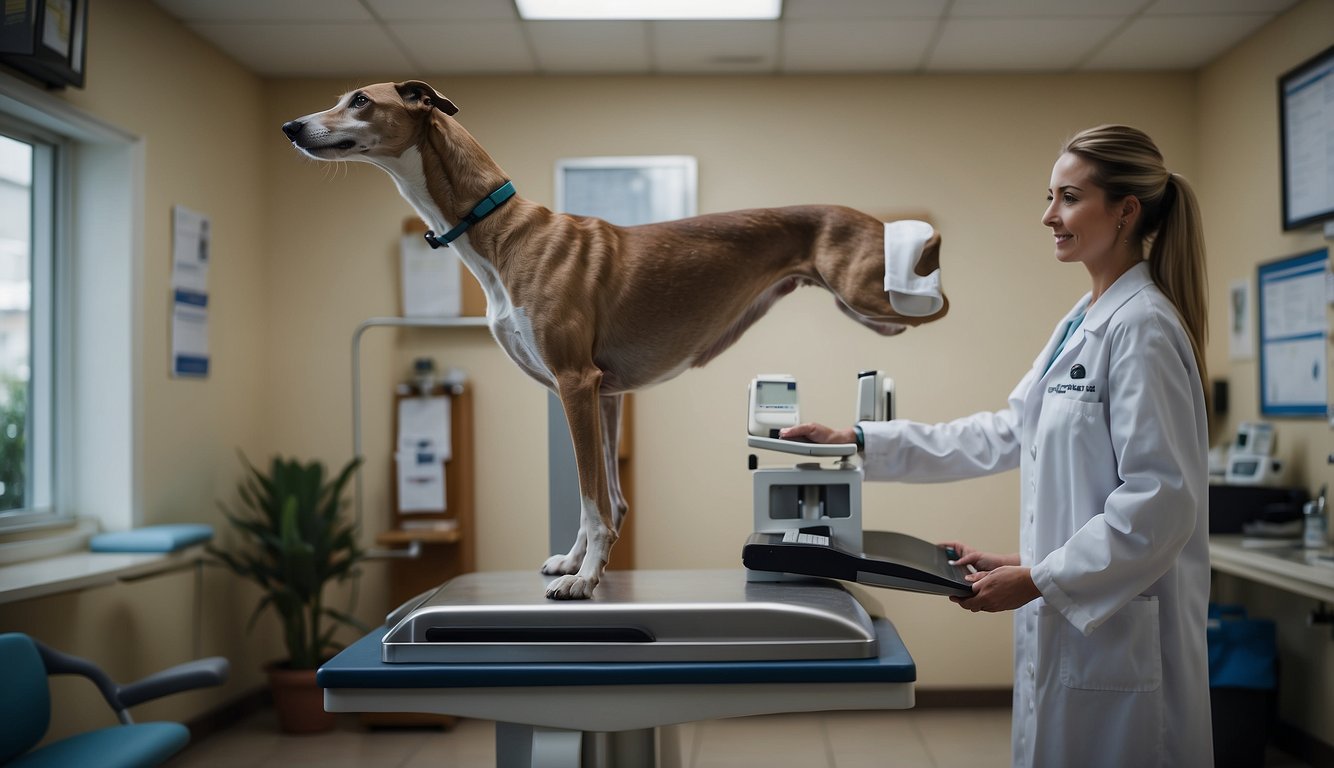Managing the weight of a Greyhound is crucial for ensuring their overall health and longevity.
These slender canines are known for their athletic build and fast speeds, but like any breed, they can be prone to weight gain if their diet and exercise are not carefully monitored.
A Greyhound’s health can be compromised by being overweight, which is why weight management is essential.
Understanding their unique nutritional needs, ensuring they receive the right amount of exercise, and regular veterinary check-ups all play integral roles in maintaining a healthy weight for your Greyhound.
Weight management in Greyhounds involves a delicate balance between diet and physical activity.
By providing a balanced diet and regular exercise schedule, you can help your Greyhound maintain an ideal weight.
Consulting with a veterinarian is key in developing a personalized weight loss plan, in cases where your Greyhound needs to shed a few pounds.
This ensures that the weight loss is safe and appropriate for your pet’s specific health requirements.
Regular monitoring and making adjustments as needed can help your Greyhound stay agile and healthy throughout their life.
Key Takeaways
- Balanced diet and regular exercise are fundamental for Greyhound weight management.
- Veterinary guidance is essential in establishing a healthy weight for your Greyhound.
- Personalized plans and monitoring are crucial for effective long-term weight management.
Understanding Greyhound Health and Weight

Maintaining a healthy weight in greyhounds is essential for their overall well-being and performance. It helps prevent a range of health issues that can affect their quality of life.
Importance of Healthy Weight
In greyhounds, carrying the right amount of weight is a cornerstone of good health.
A healthy weight contributes to optimizing their distinctive physique, which is built for speed and agility.
It ensures your greyhound has the right balance of muscle mass and body fat necessary for both the sprinting they are famous for and for maintaining everyday health.
Physical activity tailored to your greyhound’s needs is crucial for keeping them in top shape.
Common Weight-Related Health Issues
Greyhounds are at risk for several health problems if they become overweight or obese. Excess weight can lead to:
- Arthritis: Added stress on joints can exacerbate this condition.
- Diabetes: Obesity in dogs can lead to insulin resistance.
- Heart disease: Extra weight increases the workload on the heart.
Conversely, greyhounds that are underweight can lack the necessary energy and resilience, making them prone to other health issues. Maintaining a balanced weight is essential.
Body Condition Scoring for Greyhounds
Body Condition Scoring (BCS) provides a standard way for you to assess your greyhound’s body weight and overall condition. Using a scale typically ranging from 1 (very thin) to 9 (obese), you can determine where your greyhound falls:
| Score | Condition | Description |
|---|---|---|
| 1-3 | Underweight | Ribs, backbone, and hip bones are easily visible. |
| 4-5 | Ideal Weight | Ribs can be felt, with a visible waist from above. |
| 6-9 | Overweight/Obese | Ribs are hard to feel, with noticeable fat deposits. |
Regular assessments using the BCS can guide you in adjusting diet and activity levels to maintain your greyhound’s optimal weight.
Nutritional Needs of Greyhounds

Your greyhound’s health hinges on a carefully balanced diet tailored to its unique nutritional needs.
High-quality protein, sufficient fats, complex carbohydrates, and essential vitamins and minerals all play vital roles in maintaining your dog’s health.
Components of a Balanced Diet
To ensure that your greyhound thrives, its diet must contain a combination of essential nutrients. A balanced diet for greyhounds generally consists of:
- Protein: Critical for muscle repair and growth.
- Fats: Provide energy and support cell function.
- Carbohydrates: Offer a source of quick energy and fiber.
- Vitamins and Minerals: Necessary for various body functions.
Understanding Protein, Fats, and Carbs
Protein builds strong muscles and is particularly important for greyhounds due to their athletic build.
Aim for diets that provide 20-45% of energy from proteins.
Fats are dense in energy, making up 40-50% of the diet for active greyhounds. They support endurance and performance.
Carbohydrates, while less essential, still contribute beneficial energy and fiber.
These should be sourced from whole grains and vegetables for optimum nutrient absorption.
Vitamins and Minerals for Optimal Health
A range of vitamins and minerals are key to your greyhound’s health:
- Calcium and Phosphorus: For strong bones and teeth.
- Iron: For healthy blood and oxygen transport.
- Vitamin A: For good vision and immune health.
Your greyhound’s diet should either be composed of nutritionally complete commercial dog food or, if home-prepared, should be vet-approved to ensure all essential nutrients are included for pinnacle health.
Effective Weight Management Strategies

Maintaining your Greyhound’s weight is crucial for their health and longevity.
A combination of regular exercise, proper nutrition, and a consistent feeding schedule will support weight management efforts.
Regular Exercise and Physical Activity
Your Greyhound thrives on regular exercise and physical activity.
Ensuring daily walks, playtime, and opportunities to run are fundamental to preventing weight gain.
Aim for at least 30 minutes of activity a day, but adjust this based on your dog’s individual needs and stamina.
Remember that Greyhounds are sprinters by nature, so short bursts of intense activity followed by periods of rest can be particularly beneficial.
Portion Control and Feeding Schedule
Portion control is paramount in managing your Greyhound’s weight.
Feed your dog measured amounts of high-quality dog food, divided into two meals a day to help prevent overeating.
Avoid the temptation to give too many treats, and when you do, opt for healthy options like carrot sticks or lean meat.
Stick to a consistent feeding schedule to regulate your dog’s appetite and digestion.
Implementing a Weight Management Plan
Create a weight management plan tailored to your Greyhound’s needs.
Monitor their weight and adjust their diet and exercise routine accordingly.
Regular vet check-ups will help keep track of your dog’s progress and health.
If you notice any unexpected weight gain, reassess their activity levels and nutrition, and make changes to get back on track.
Choosing the Right Dog Food

When it comes to keeping your Greyhound healthy and at an ideal weight, the right dog food is crucial. Quality ingredients and a balanced diet are key to maintaining their lean muscle mass and ensuring a high standard of life.
Benefits of High-Quality Protein
High-quality protein is the cornerstone of a nutritious diet for your Greyhound. It’s essential for maintaining lean muscle mass and supporting overall health.
Choose dog foods that list real meat, like chicken, fish, or even kangaroo, as the first ingredient.
These protein sources are not only packed with nutrients but are also more likely to cater to dogs with sensitivity to more common proteins.
Grains, Veggies, and Fiber
A balance of grains, vegetables, and fiber is important for your dog’s diet.
Whole grains can be a good source of energy, and veggies provide essential vitamins and minerals. Fiber is necessary for healthy digestion.
When selecting dog food, look for natural ingredients like peas and chickpeas, which offer both protein and fiber. Flaxseed is also beneficial, as it’s rich in omega-3 fatty acids, which contribute to a shiny coat and good skin health.
Transitioning to a New Diet
If you’re transitioning to a new diet, do so gradually to avoid upsetting your dog’s stomach. Veterinarians recommend a transition schedule over a period of days.
- Days 1-2: 75% old food, 25% new food
- Days 3-4: 50% old food, 50% new food
- Days 5-6: 25% old food, 75% new food
This allows your Greyhound’s digestive system to adjust and can prevent the risk of gastrointestinal upset, such as vomiting and diarrhea.
If any health issues arise, consult your veterinarian — making changes based on professional guidance will best support your dog’s health.
Exercise and Play for Greyhounds

Maintaining your Greyhound’s weight is not just about diet, but also making sure they have the right balance of exercise and play. The right physical activities can help manage their weight effectively while ensuring they’re happy and healthy.
Regular Exercise Routines
To keep your Greyhound in top form, daily walks are essential.
Aim for at least 1 hour of exercise per day, which can be divided into shorter walks to suit your schedule and your dog’s energy levels.
Here are key points for your Greyhound’s regular exercise:
- Walks: Moderate-paced walking provides cardiovascular benefits without overtaxing their system.
- Running: Occasional sprints in a safely enclosed area can help them exert natural bursts of speed.
- Consistency: Keeping a consistent routine helps manage both weight and energy levels.
Interactive Toys and Mental Stimulation
Physical activity should be complemented with mental exercise.
Interactive toys enhance your Greyhound’s mental stimulation, which is just as vital as physical activity for their overall well-being.
Use toys that require them to solve puzzles or work for their treats.
This will not only entertain them but also help prevent boredom and related issues.
Safe Activities for Senior Greyhounds
For senior Greyhounds or those with mobility issues, it’s important to adjust activities to match their ability and comfort level.
Low-impact exercise like gentle walks or swimming can be beneficial.
Always monitor for signs of discomfort or mobility issues, especially if your Greyhound has existing health conditions.
Here’s what you should consider for senior Greyhounds:
- Shorter, more frequent walks to maintain mobility without causing strain
- Playtime that is gentle on the joints, like soft toy fetching
- Regular vet checks to monitor their physical condition
Healthcare and Regular Veterinary Check-Ups

To ensure your Greyhound maintains a healthy weight, it’s vital to integrate comprehensive healthcare measures with regular veterinary check-ups.
Focusing on preventive healthcare, dealing appropriately with health complications, and considering the use of supplements and specialized diets will play a significant role in their overall well-being.
Preventive Healthcare for Weight Management
Effectively managing your Greyhound’s weight begins with preventive veterinary care. This includes:
- Routine Examinations: Regular appointments with your veterinarian help catch early signs of health conditions like obesity that can impact your Greyhound’s heart and joint health.
- Vaccinations and Parasite Control: Keep up with your dog’s vaccination schedule and use recommended parasite prevention methods.
Dealing with Health Complications
If health issues arise, addressing them promptly can prevent complications related to weight:
- Early Detection: Health conditions such as arthritis or respiratory issues can affect your Greyhound’s exercise routine, leading to weight gain. Regular vet visits allow for early diagnosis and treatment.
- Monitoring Heart Health: Your veterinarian will monitor your Greyhound’s heart function, as weight management is crucial in preventing cardiac problems.
Supplements and Specialized Diets
In some cases, supplements and specialized diets may be recommended:
- Joint Supplements: Products containing glucosamine and omega-3 fatty acids may support joint health, particularly important for maintaining mobility and a healthy weight.
- Tailored Nutrition Plans: Your veterinarian might propose a diet plan rich in nutrients essential for your Greyhound’s specific health needs, potentially extending their lifespan.
Caring for Your Greyhound’s Weight at Home

Maintaining your Greyhound’s weight is vital for their health and quality of life. As a responsible pet owner, you can manage your dog’s weight through careful monitoring of their diet, adjusting treat intake, and making appropriate lifestyle changes.
Monitoring Weight and Diet at Home
To ensure your Greyhound stays at a healthy weight, keep a consistent feeding schedule and measure out their food using a standard measuring cup.
Adult Greyhounds typically require around 2.5 to 3 cups of high-quality dog food per day, split into two meals.
Regularly track your dog’s weight by:
- Weighing them at least once a month.
- Checking for a visible waistline and feeling for their ribs beneath a thin layer of fat.
Monitoring these indicators can help you determine if dietary adjustments are needed.
Addressing Overfeeding and Treat Intake
Overfeeding and excessive treat consumption can easily lead to weight gain and obesity in your Greyhound. To avoid this:
- Limit treats to 5% or less of their daily caloric intake.
- Choose healthy treat options like carrots or apples.
- Be mindful of the calories in each treat and reduce their regular meal portion sizes accordingly.
By controlling treat distribution, you’ll help manage your dog’s overall caloric intake and prevent obesity.
Lifestyle Adjustments for a Healthy Weight
A sedentary lifestyle can contribute to weight gain in Greyhounds. To ensure your Greyhound maintains a healthy weight and energy levels:
- Incorporate daily exercise, such as walks or runs, according to their energy levels.
- Provide regular opportunities for play and mental stimulation.
- Maintain an active lifestyle to prevent a decline in your Greyhound’s muscle mass and overall health.
Frequently Asked Questions (FAQs)

In tackling the complexities of managing your Greyhound’s weight, you may have several questions. Below are some focused FAQs providing you with precise advice to maintain your Greyhound’s best health.
What are the recommended supplements for managing a Greyhound’s weight?
To support your Greyhound’s weight management, consider supplements rich in omega-3 fatty acids for metabolism and joint health. Always consult your vet before beginning any supplement regimen.
What diet is best suited for maintaining a healthy weight in Greyhounds?
A diet for a Greyhound should be high in quality proteins and have a balance of carbohydrates and fats. Portion control is crucial, and choosing a diet formulated for athletic breeds can be beneficial.
How can I help my Greyhound lose weight in a safe and healthy manner?
Incremental increases in exercise, paired with a carefully measured diet, are key. Try more frequent, less intense walks and monitor treat intake closely.
What should a Greyhound’s weight chart look like for optimal health?
Your Greyhound’s weight chart should reflect a gradual curve in growth and plateau into a consistent, ideal weight as an adult. Regular vet check-ups can help you maintain this ideal weight.
How can a Greyhound that’s underweight be healthily encouraged to gain weight?
For underweight Greyhounds, increase caloric intake with nutritious, high-calorie foods and ensure there is an adequate amount of protein to build muscle. Consult with your vet to tailor a feeding plan.
How much food is appropriate for a Greyhound weighing around 70 pounds?
A 70-pound Greyhound typically needs about 1,500 to 1,800 calories per day. However, this can vary based on activity levels and individual metabolism. A vet can help determine the right amount.



